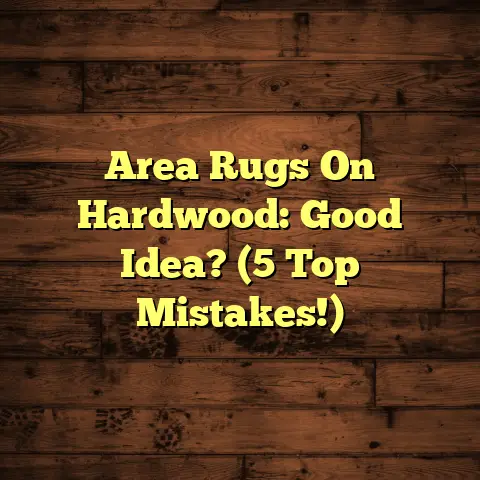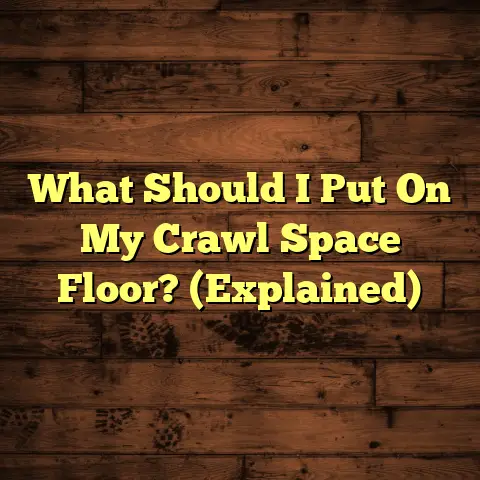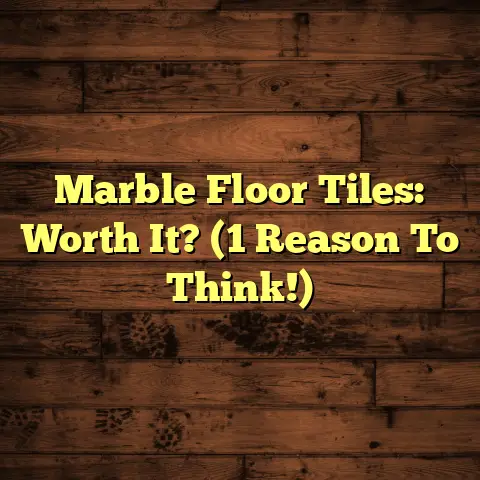What Type Of Vapor Barrier To Use Under Hardwood Floor? (Explained)
When considering hardwood flooring installation, one critical component that often gets overlooked is the vapor barrier.
A vapor barrier is a material designed to resist moisture transmission.
I learned this the hard way during my first hardwood floor installation—moisture issues can lead to warping, mold, and a host of other problems.
In this comprehensive guide, I’ll take you through everything I’ve learned about vapor barriers, including types, installation tips, maintenance considerations, and my personal experiences with each type.
This information will empower you to make informed decisions for your own flooring projects.
What is a Vapor Barrier?
A vapor barrier serves as a protective layer between the ground and your hardwood flooring.
It’s particularly important in areas with high moisture levels, such as basements or homes located in humid climates.
The primary function is to prevent moisture from seeping up from the ground or through the walls, which can damage your floors over time.
Moisture can be a silent enemy.
During my first hardwood flooring project in a basement, I didn’t think much about moisture control.
After a few months, I noticed some buckling in the boards.
Upon closer inspection, I found that moisture had seeped up from the concrete slab.
This experience taught me that a proper vapor barrier is not just an option; it is essential for the longevity of hardwood floors.
Types of Vapor Barriers
There are several types of vapor barriers available on the market.
Each has its unique properties, benefits, and drawbacks.
Here’s a detailed look at the most common options:
1. Polyethylene Sheets
Description: Polyethylene sheeting is the most common type of vapor barrier.
It is a plastic film typically available in thicknesses ranging from 4 mil to 10 mil.
Cost: I used 6-mil polyethylene sheets for my basement project, which cost around $0.20 per square foot.
Installation Experience: The installation is straightforward.
I laid it down over the entire area before putting down the underlayment and hardwood.
One important tip is to ensure you overlap the seams by at least 12 inches.
- Advantages:
- Affordable and widely available.
- Easy to install for DIY enthusiasts.
- Disadvantages:
- Can tear easily if not handled carefully.
- Limited insulation properties.
2. Foam Vapor Barriers
Description: Foam vapor barriers come in various thicknesses, usually ranging from 1/8 inch to 1/4 inch.
They are often made from closed-cell foam materials, which provide moisture resistance along with insulation.
Cost: The cost is higher than polyethylene sheets, around $0.50 to $1.00 per square foot.
Installation Experience: I found that foam barriers are a bit thicker and require more careful handling during installation.
However, they offer better insulation than polyethylene sheets.
- Advantages:
- Provide both moisture resistance and insulation.
- Great for areas where temperature fluctuations occur.
- Disadvantages:
- More expensive than polyethylene.
- Can be challenging to find in some regions.
3. Radiant Barriers
Description: Radiant barriers are typically reflective materials that help manage heat and moisture.
They consist of aluminum foil or similar materials that reflect radiant heat away from living spaces.
Cost: Radiant barriers usually cost about $1.50 per square foot.
Installation Experience: In my friend’s home, where they installed heated floors, we opted for radiant barriers.
The installation was more complex due to the need for precise placement to ensure effective heat reflection.
- Advantages:
- Help reflect heat back into the room while controlling moisture.
- Ideal for homes with radiant heating systems.
- Disadvantages:
- More complex to install; requires careful planning.
- Significantly more expensive than other options.
4. Asphaltic Membranes
Description: Asphaltic membranes are thicker and more robust than polyethylene sheets, often used in commercial applications but finding their way into residential projects as well.
Cost: These membranes can range from $1.00 to $2.00 per square foot based on quality and thickness.
Installation Experience: I once assisted a neighbor with an installation using asphaltic membranes in a high-moisture area.
The installation was labor-intensive but ultimately offered peace of mind due to their durability.
- Advantages:
- Extremely effective in high-moisture environments.
- Durable and long-lasting.
- Disadvantages:
- Heavier and more challenging to install.
- More costly than traditional options.
Installation Tips
I learned some valuable lessons during my installations that I’d like to share:
Surface Preparation
Before laying down any vapor barrier, ensure the subfloor is clean and dry.
Any debris or moisture can compromise the effectiveness of the barrier.
I remember spending an extra hour cleaning up after a previous contractor’s work before starting my own project.
Overlap Seams
If you opt for sheets, overlap the seams by at least 12 inches to prevent moisture from sneaking through.
Use tape designed for vapor barriers to seal seams and edges.
This step is often skipped, but it is critical for maintaining a moisture-free environment.
Use a Moisture Meter
Investing in a moisture meter can be a game changer.
Before installation, I always check the moisture level in the subfloor and surrounding environment.
Ideally, you want a reading below 15% before installing your vapor barrier and flooring.
Install During Dry Seasons
If possible, schedule your installation during dry weather conditions.
Doing so reduces the risk of moisture infiltrating your new flooring while you work on it.
Maintenance Considerations
Once installed, maintaining your vapor barrier isn’t something that requires frequent attention, but it’s essential to check for signs of moisture or damage periodically:
- Annual Inspections: In my experience, inspecting once a year is sufficient.
Look for any signs of mold or mildew that could indicate moisture issues beneath your floors. - Monitor Humidity Levels: Using a hygrometer to keep an eye on indoor humidity levels can help you catch potential issues early.
- Check for Tears or Damage: If you notice any issues with your hardwood flooring over time, consider checking the vapor barrier underneath it.
Common Problems and Solutions
Over the years, I’ve encountered several challenges related to vapor barriers:
Problem: Warping Floors
I once installed hardwood flooring without realizing that the vapor barrier had been compromised during installation, leading to warping after just a few months.
Solution: Always double-check that your vapor barrier is intact before laying down hardwood flooring.
If you suspect an issue afterward, you may need to lift some boards for inspection.
Problem: Mold Growth
In another instance, I found mold growing underneath my hardwood due to excessive humidity levels in the basement combined with an inadequate vapor barrier.
Solution: I installed a dehumidifier in the basement and replaced the vapor barrier with a higher quality foam option that could handle humidity better.
Cost Considerations
Understanding costs is crucial when planning your flooring project:
- Budgeting for Materials: Depending on your choice of vapor barrier, materials can range from $0.20 (polyethylene) to $1.50 or more (radiant barriers) per square foot.
- Labor Costs: If you’re hiring professionals, labor costs can vary significantly based on location and complexity of installation.
- Long-term Savings: Investing in a quality vapor barrier may seem like an upfront expense but can save money in the long run by preventing damage and prolonging the life of your flooring.
Environmental Impact
As we become more conscious of our environmental footprint, it’s worth considering the materials we use:
- Recyclable Options: Some manufacturers offer recyclable vapor barrier solutions made from eco-friendly materials.
- Energy Efficiency: Using effective insulation materials can reduce energy consumption by regulating indoor temperatures better.
Personal Experiences with Different Products
Throughout my journey with flooring projects, I’ve tried various products:
- Polyethylene vs.
Foam- Initially, I went with polyethylene due to its low cost but quickly switched to foam for its insulation properties after experiencing cold floors in winter months.
- Radiant Barriers Success
- In my friend’s house with radiant heating, we saw significant energy savings after installing radiant barriers.
The floor felt warmer immediately compared to previous setups without them.
- In my friend’s house with radiant heating, we saw significant energy savings after installing radiant barriers.
- Long-term Durability of Asphaltic Membranes
- For my neighbor’s high-moisture basement project, asphaltic membranes proved their worth over time by preventing any moisture-related issues for years.
Conclusion
Choosing the right vapor barrier depends on your specific needs—whether it’s cost, insulation, or moisture control.
My journeys through various flooring projects have taught me the importance of this often-overlooked element.
By selecting the appropriate vapor barrier and following proper installation techniques, you can protect your investment in hardwood flooring for years to come.
Ultimately, ensuring that you have a solid plan in place before starting your project will make all the difference in achieving successful results with your hardwood flooring installation.
Whether you’re a seasoned DIYer or hiring professionals, understanding vapor barriers will empower you to make informed decisions that enhance the beauty and longevity of your home’s floors.
By sharing these insights and experiences, I hope to encourage others to pay attention to this critical aspect of flooring installations—because no one wants to deal with warped floors or mold growth after all that hard work!




